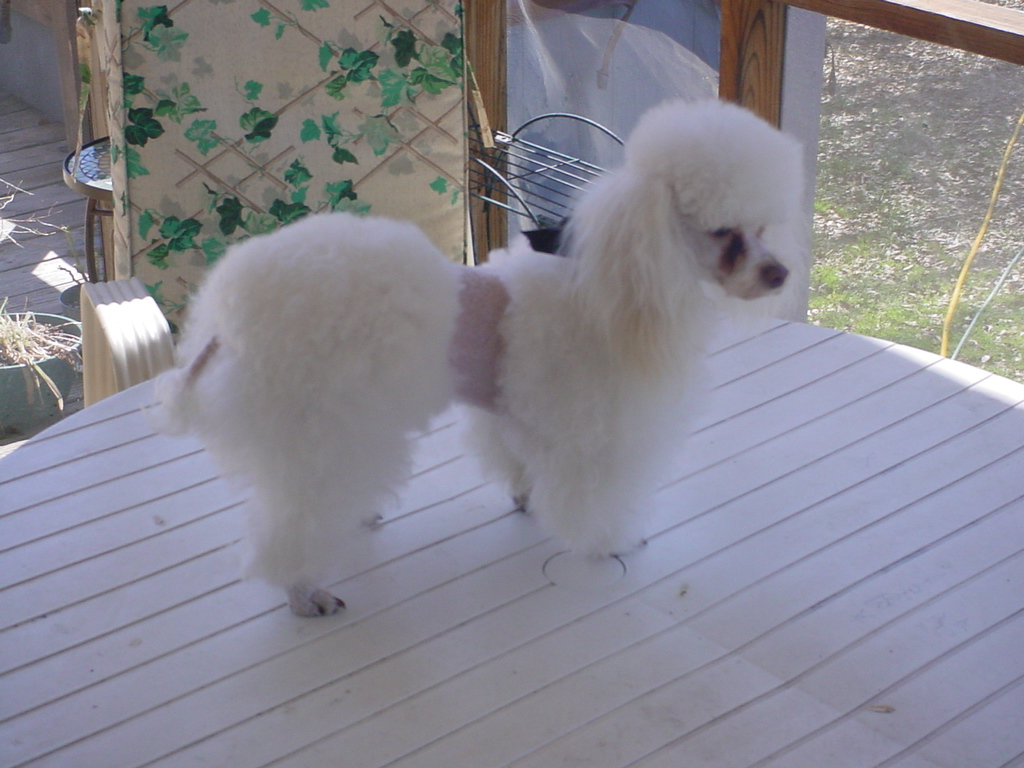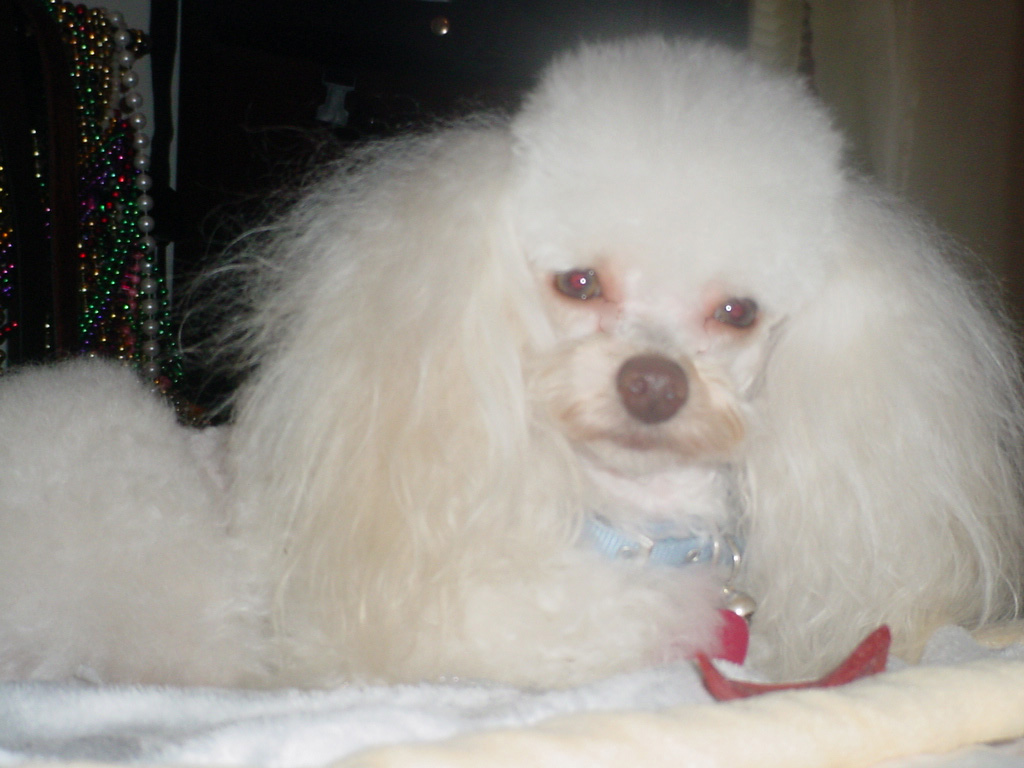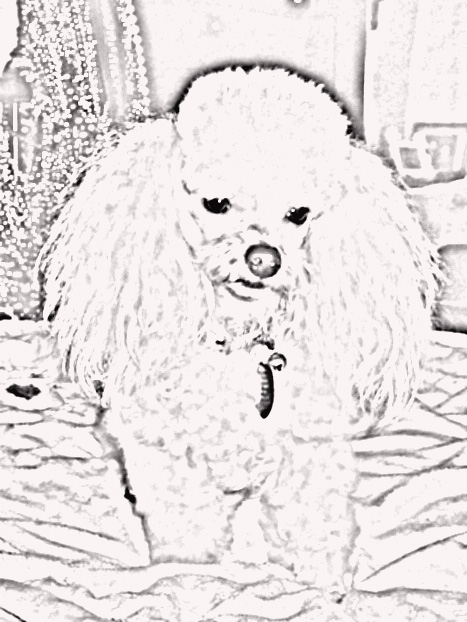JOY'S
Joy is the feeling of grinning on the inside
|
TOY POODLE
Description
The Toy Poodle is an elegant, lively, small dog with a
profuse, but well-groomed and clipped curly coat. The ears
are long, flat and wide, laying close to the head. The head
is long with dark, almond-shaped eyes that have an alert
expression. The skull is a bit rounded, with a slight stop.
The teeth should have a scissors bite. A good Poodle has a
square silhouette, with approximately the same overall
length as the height at the withers. The level top line has
a slight depression behind the withers. The feet are small,
oval and webbed, with arched toes. Dewclaws generally are
removed. The tail is docked to produce a balanced dog. The
coat may be groomed into three basic styles: the "pet clip"
(or puppy clip), with relatively short hair all over the
body, the "English saddle" clip, and the "Continental" clip
with the rear half of the body shaved, bracelets left around
the ankles, and pom-poms left on the tails and hips. All
solid colors are permissible. The Poodle has a delightful
springy gait.
Temperament
The Toy Poodle is sensitive and remarkably intelligent.
Highly responsive, they are said to be one of the most
trainable breeds. Pleasant, happy, perky and lively, they
like to be with people. Demanding and delightful; very
amusing and clever, but they are reserved with strangers and
should be socialized as a puppy. It makes a very good
watchdog for its size. Any effort the owner puts into
training and socializing will be well rewarded. Some
bloodlines may be high-strung and timid. They may snap if
they are teased or surprised. They do best with older,
considerate children and are generally good with other pets
and dogs. Unless trained, this breed tends to bark a lot.
Health Problems
Some are prone to ear infections, runny eyes, digestive
tract and heart disorders, skin conditions, slipped stifle
and PRA. Also IMHA (Immune Mediated Hemolytic Anemia)
Living Conditions
Toy Poodles are good for city life as well as country
living. They are very active indoors and will do okay
without a yard.
Exercise
These are active little dogs, who need a daily walk.
Play will take care of a lot of their exercise needs,
however, as with all breeds, play will not fulfill their
primal instinct to walk. Dogs who do not get to go on daily
walks are more likely to display behavior problems. They
will also enjoy a good romp in a safe open area off lead,
such as a large fenced in yard.
Life Expectancy
12-15 or more
years.
Grooming Poodles must be bathed regularly and clipped every six weeks. Clean and check the ears frequently for wax or infection and pull out hairs growing inside the ear canal. The traditional clips were developed to lighten the weight of the coat for swimming and to protect the joints and major organs from cold, but many pet owners opt for a plain lamb clip (the same length all over). The teeth need regular scaling. Poodles shed little to no hair and are good for allergy sufferers.
Origin
Although the Poodle has been known throughout Western Europe
for at least 400 years, its origin is controversial. Whether
it was developed in France, Germany, Denmark, or the ancient
Piedmont, is uncertain. Despite the claims of several other
countries, France has now been officially recognized as its
country of origin, and the breed occupies a special place in
the affections of the French. It is certain that the Poodle
is descended from a now nearly extinct French water dog, the
Barbet and possibly the Hungarian Water Hound. The name
'Poodle' probably derives from the German word "Pudel,"
which means: one who plays in water. The Poodle is used as a
gun dog. They were originally used in Germany and France as
a retriever of waterfowl. Hunters clipped the dog's thick
coat to help them swim, leaving hair on the leg joints to
protect them from extreme cold and sharp reeds. The French
capitalized on the breed's high intelligence, trainability &
innate showmanship and made the Poodle into a circus
performer. His great popularity in that country led to the
breed's common name "French Poodle." In France, however, the
Poodle is called the "Caniche," or duck dog. The Poodle has
been used to sniff out truffles lying underground in the
woods. Poodles are depicted in 15th century paintings and in
bas-reliefs from the 1st century. Toy Poodles became royal
favorites, particularly in the 18th century. The Toy and
Miniature varieties were bred down from larger dogs, today
known as Standard Poodles. The
three sizes are considered as one breed, and are judged by
the same standard. Today, the Poodle is primarily a
companion and show dog, though he can learn almost anything.
|


I'm absolutely, totally in love with my little Harley Rhett Easyrider! He's an absolute doll! Have you ever seen such a sweet face?
If you want a fabulous pet and will take the time to train, they're exceptional!


- These really are very sensitive dogs, which means you have to be prepared for this when training. Your toy poodle will study your face and every move with an incredible attention to detail: if you seem angry or upset, she will know, and will become anxious and worried. Don't train if you're in a bad mood: keep it cheerful, gentle, and upbeat. Your toy poodle will respond eagerly to positive reinforcement training and praise for good behavior.
- Fortunately, these dogs are the easiest of all toy breeds to house train. Your toy should be trained in a matter of weeks - provided that you've stuck to the basic crate-training method (puppy or dog is in the crate at all times unless she's outside relieving herself, eating, or is actively being played with).
- I'd recommend that you get your toy poodle involved in obedience classes and, if possible, agility work (obstacle courses). These dogs have a tremendous appetite for learning difficult, complex tricks (balancing and 'thinking' tricks are taken to particularly well) and will welcome the challenge - it's also a great way to bond with your toy poodle.
- Try to keep stress to a minimum in your house. If there's regular fighting, angry and emotional people, or lots of stress, your toy poodle will sense it and will become ill or very upset herself. Poodles are calm dogs who need a calm environment to flourish in - if you don't want a neurotic, unhappy dog (with the resultant problematic behaviors) then try to keep it cool at home.
Harley's Breeder 's Information
Madeline Queen
Shelby, NC
(704)-434-5565
These are wonderful people!
